May 21st, 2018
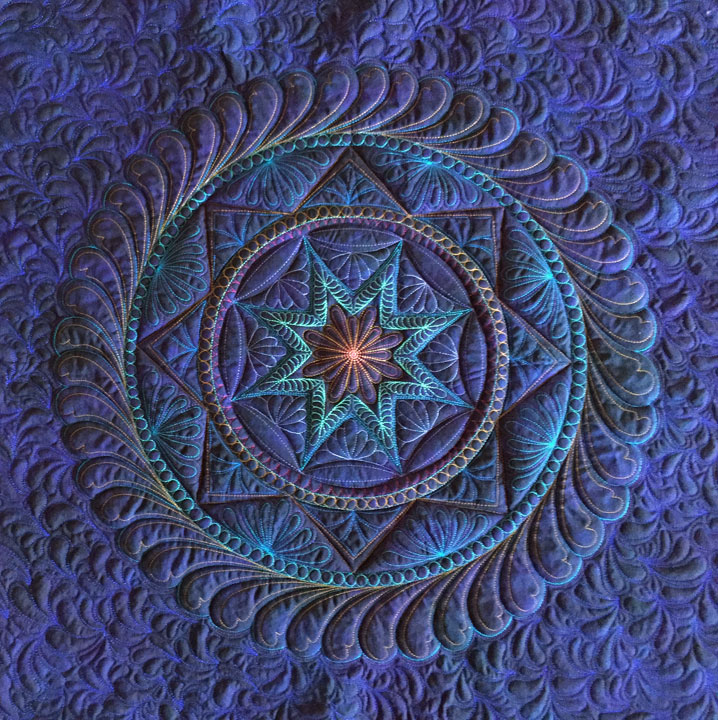
This trapuntoed feathered wreath was rescued from a quilting UFO pile. It’s a good example of how you can use trapunto to visually direct the viewer’s eye to see “zones” of a design by preferentially adding more dimension to certain portions of a given quilted design. Different portions of this have 1 layer of batting, some have 2, some have 3, and 1 section has 4 layers of batting. Between trapunto and how densely you choose to quilt portions of a design, you have tremendous control over how someone perceives or “sees” the design your are creating. I’ll walk you through the process below, and know that these photos were all taken on different days, in different rooms, and in different lighting, so the colors will keep changing!
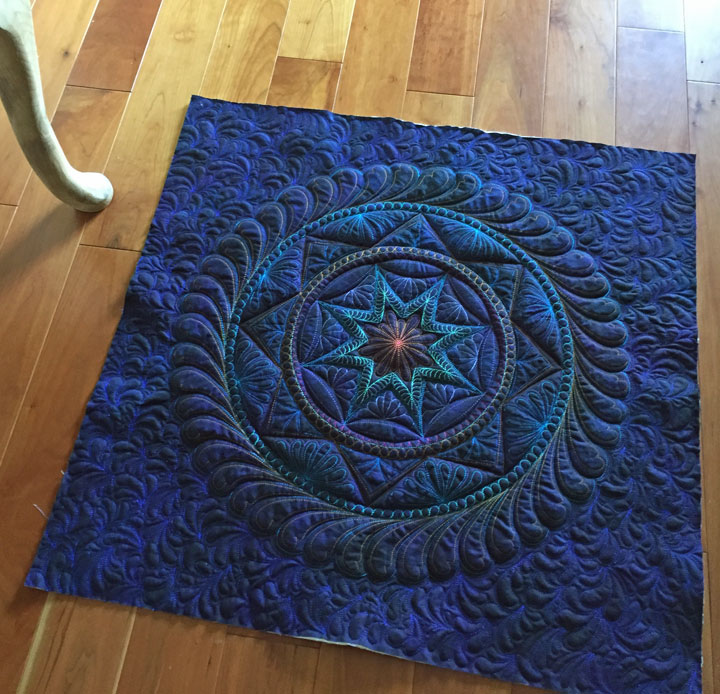
It started as a piece of commercial black mottled fabric that I over-dyed with purple. I then quilted the center star using a digital file on my embroidery machine, (you can find that design file by clicking here), and threw a scrap of polyester batting under the whole square but there was no backing fabric. I started to enlarge that center design using arc rulers, but this all came to a screeching halt 2-3 years ago because I wasn’t sure I liked what I’d done. This UFO has been sitting in my giant tote bag for all this time, waiting for me to do something. I cleaned out the tote bag last week and ripped out what I’d started earlier and then went to work making a large feathered wreath.
My first move was to use my PTD 6.5 arc and PTD12 arc rulers to create a circular chain of 2-tiered crescents that surrounded the star:
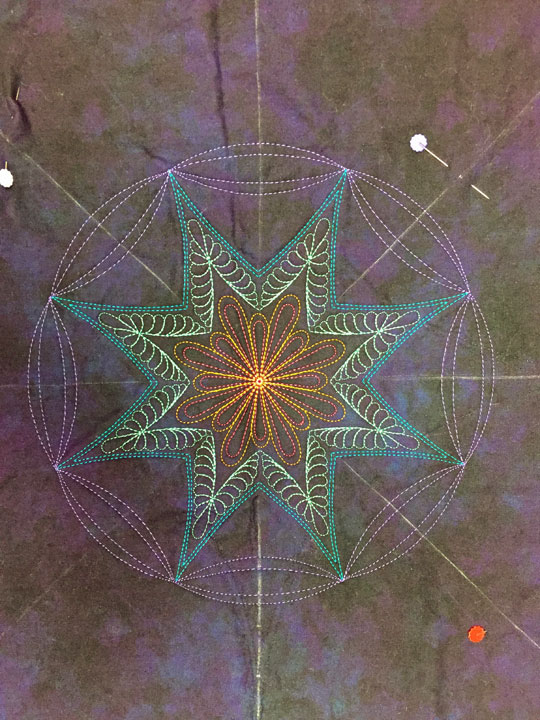
(The pins that you see are holding another layer of polyester batting that will fall underneath the entire wreath.) Next up, I started by adding multiple circles to create “zones” in the spine area. I got to break out my new set of Westalee Circle Rulers that allow me to make circles up to 18 inches in diameter:

(These larger circle templates work exactly like the earlier Westalee ones, but you can see that they provide channels for creating larger circles. You can find the Westalee COQ set 6 templates in our online store by clicking here.) I then marked a circle in soap that gave me 2 3/4 inches for my outermost plumes. This soap line is a temporary line that serves as the boundary for the edges of the plumes:

Here’s what it looked like once I added the plumes. You can see that even though they are all a bit different since I’m adding them freehand, they still look pretty symmetric and it’s all because of stretching the plumes to the soap line:

Next, I began filling in the narrow channels. A single row of pearls is a great way to fill a 1/2 inch wide channel, and quilting this in a gold polyester thread will add a little bling and help “set off” that circle well:
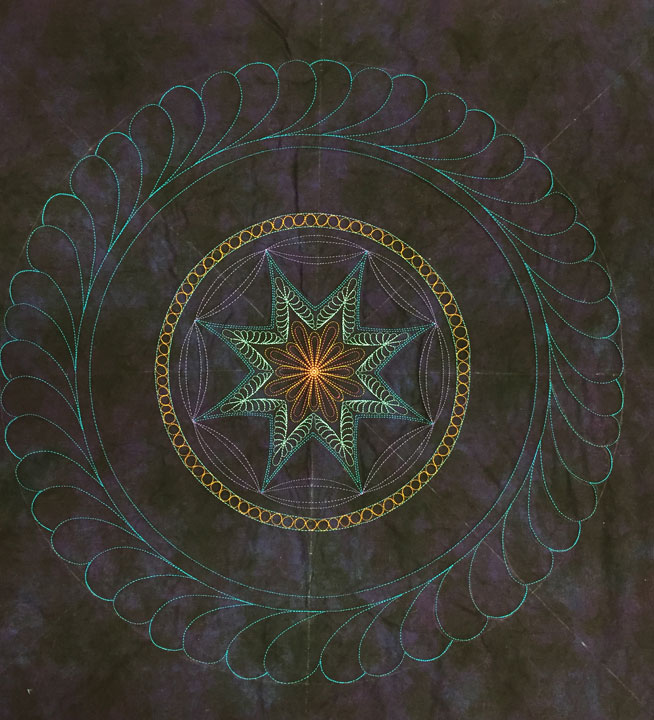
In this next shot, you can see I’ve added fingertips (magenta polyester thread) inside the irregular channel that falls between the pearls and the circle of crescents, and also added small featherettes (lavendar polyester thread), inside the space interior to the crescents:
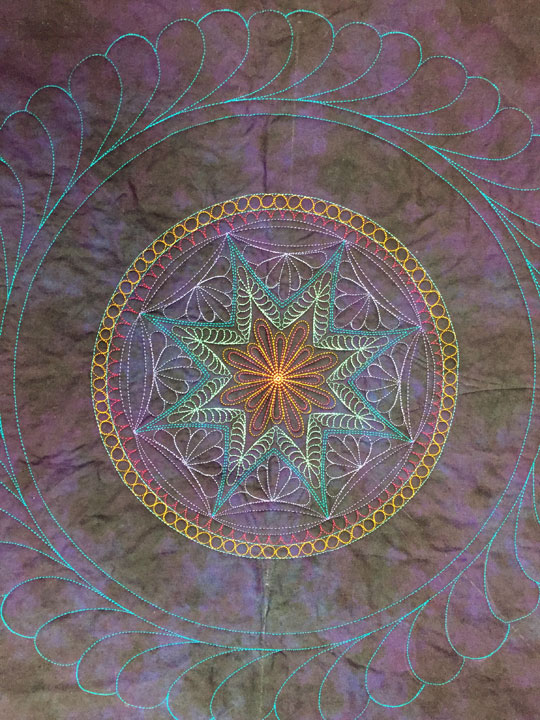
…and the last thing I did on this day was to add a single row of pearls in the outermost 1/2 inch wide channel:

I had no idea of what I wanted to place in that wide channel, so I walked away from the project to think about it overnight. I cut away the excess batting that fell outside the wreath before I called it a day, so here’s what the project’s backside looked like at that point:
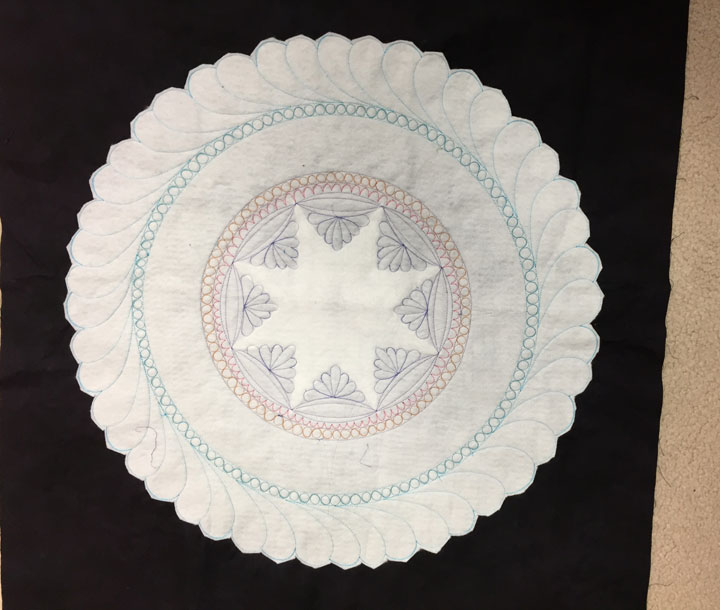
(Just to make it clear, there are 2 layers of batting underneath the center star, and 1 layer underneath the entire wreath at this point.) I decided to add a series of triangles surrounding the circle, so I created those using a straight line ruler and then created a tapered channel inside those rays:
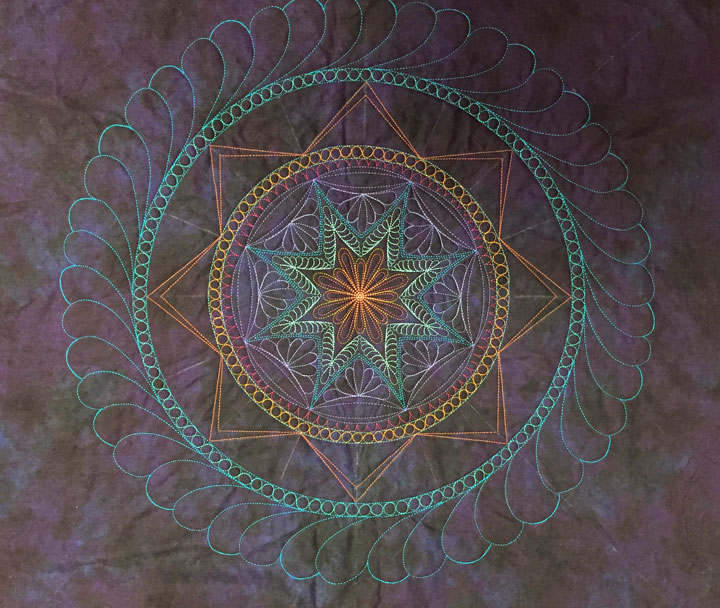
…and here I have added an Aztec featherette (dark blue polyester thread) inside each of the rays:
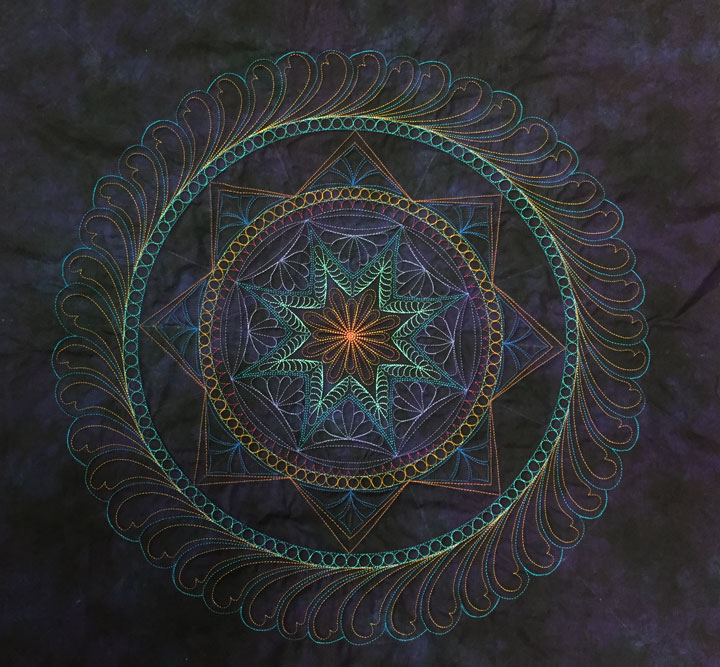
…and I’ve now added a featherette inside the outer triangle spaces:

These are not very striking, so I added hyperquilting inside the featherettes in turquoise thread. You can kind of appreciate how much this adds in the next photo that shows some hyperquilted and others not yet hyperquilted:

Now, it is starting to get exciting, and remember, all this drama is being created using thread! Here’s a shot once the whole wreath is done; you can see that it’s cool but seems king of “flat:”

Here is where I decided I wanted to set off different zones more, so I threw in yet another extra layer of batting that covered the entire center “circle” that ends with the gold pearls. I wanted to exaggerate the difference between the 2 “featherette zones” inside that outer wide channel, so I added small pieces of batting over the outermost triangles. Here is a shot of what the back side of this piece looked like at that point:

The rest is a downhill coast as I layered it unto the final quilt sandwich with a final layer of batting underneath the whole thing, followed by a backing fabric. I preferentially stitched outside certain zones of design to set them off, and here is the finished product:

Another UFO rescued…or at least it will be once I make the time to bind it!

Filed under
Free Motion Quilting, ruler work on a HDSM.
May 17th, 2018
I had hoped to finish this rescued UFO last night but it didn’t happen. I’ll post more photos later once it’s done:
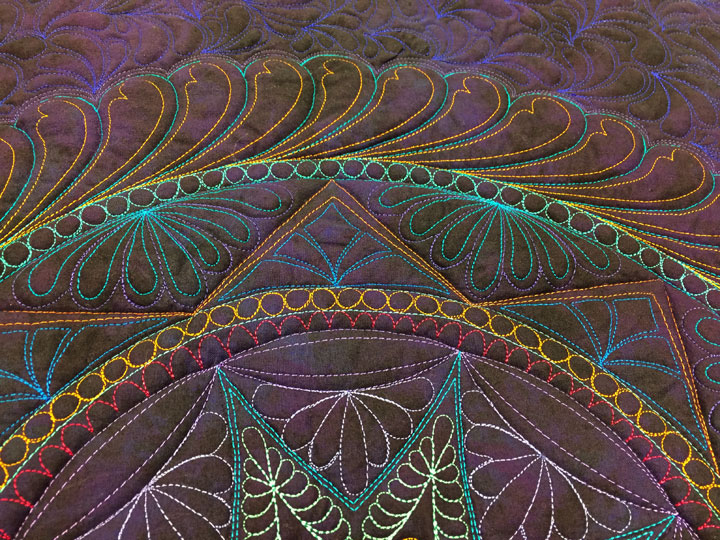

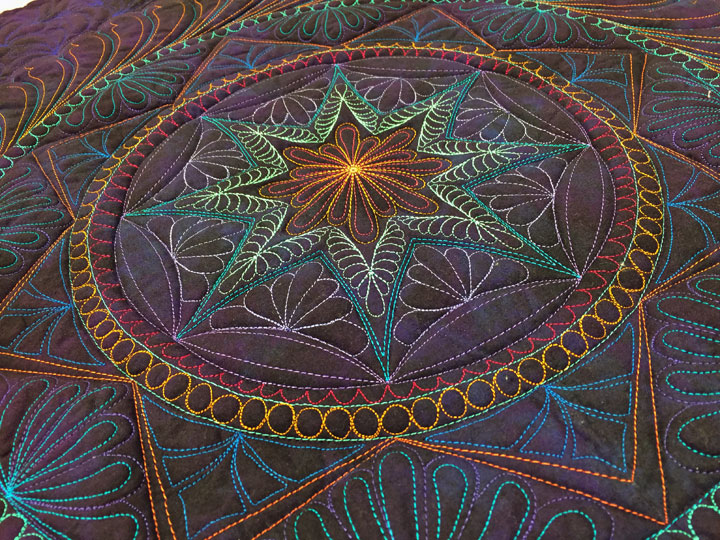
Filed under
Free Motion Quilting, ruler work on a HDSM.
May 10th, 2018

Can’t seem to stop creating these! There is no end to how one can divvy up the real estate that lies inside an arched swag framework. I used my PTD 12 arc ruler to make the initial framework, then threw in a 1/4 inch parallel channel, then a 1/2 inch parallel channel, and then a 3rd 1/4 inch parallel channel:

(Remember, all parallel channels are made using whatever ruler was used to create the original framework, so the PTD 12 arc was the ruler used for all the channels.) Next up, I threw in a melon shape along the center vertical axis. I used the PTD 6.5 arc for this, then threw in a tapered channel using the PTD 12 arc ruler:

I then added a featherette to fill the “empty spaces” surrounding the center melon:

…and then I added a row of pearls inside the 1/2 inch parallel channel:

…then finished up with a row of pearls inside the center melons:

I love, love, love designs that merge ruler work and feathers…can you tell?!
Filed under
Free Motion Quilting, ruler work on a HDSM.
May 6th, 2018
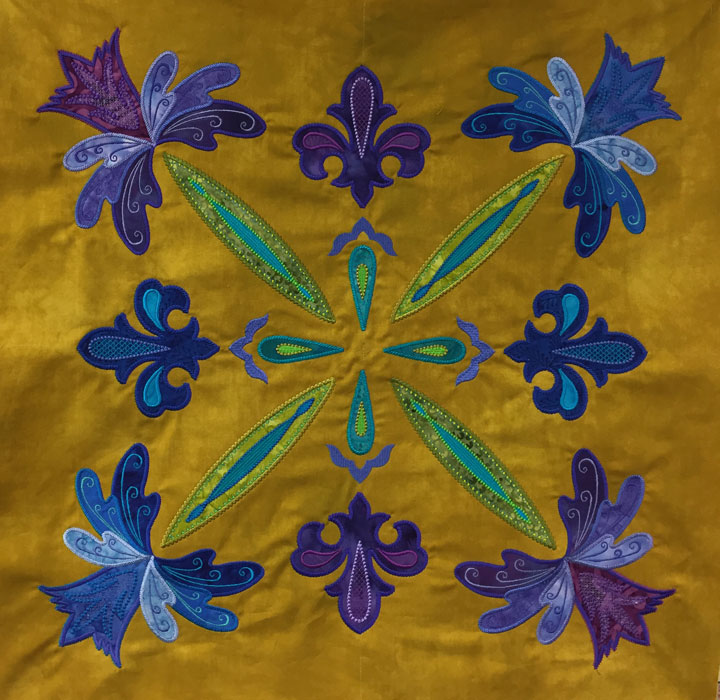
I’ve been experimenting with a new large quilt block design and I’m calling it the Fantasy Flower Block. This is another machine embroidery applique block, (meaning that it is appliqued and embroidered using an embroidery machine), and after multiple revisions, I’ve settled on the final block above. This a large block, (24 inches square), and it’s created in 4 hoopings. Each block takes nearly 3 full days of dedicated work to complete. All of the applique shapes were cut on my Sizzix Big Shot machine except for the stems, which were traced and cut by hand. I like some of the details so I tried to take some close ups to show them. Here is a close up of one of the flowers:

The center-most part of the flower (i.e. the thistle part of the flower), has a dual edge border treatment that I’ve never tried before. I was trying to add a sense of “prickliness” or a “menacing nature” to that thistle, so we added those spikey edges. I like the contrast of having an adjacent satin stitch right up against that prickly edge. I also really like the stems. Here is a shot of 4 stems converging in the center area:

(Sorry, you need to ignore that center crosshair! I guess I forgot to remove it before taking the photo!) Each block holds 2 pairs of identical stems. Here’s a shot of one color option on this block:

…and here’s a shot of another stem in a different colorway:
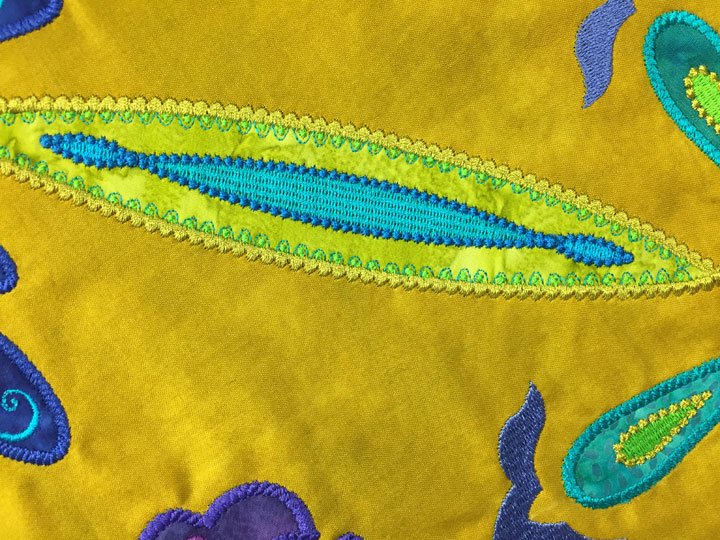
Here is a close up of a portion of a stem so you can see the details better:

I’ve used this same dual edge finishing design many times now, but it never ceases to amaze me! I love the complexity of this design so I’m sure you’ll see me use it again. Here’s a shot of one of the fleur-de-lis shapes; their embroidered details are pretty “vanilla,” but I needed some “quiet places” on the block:
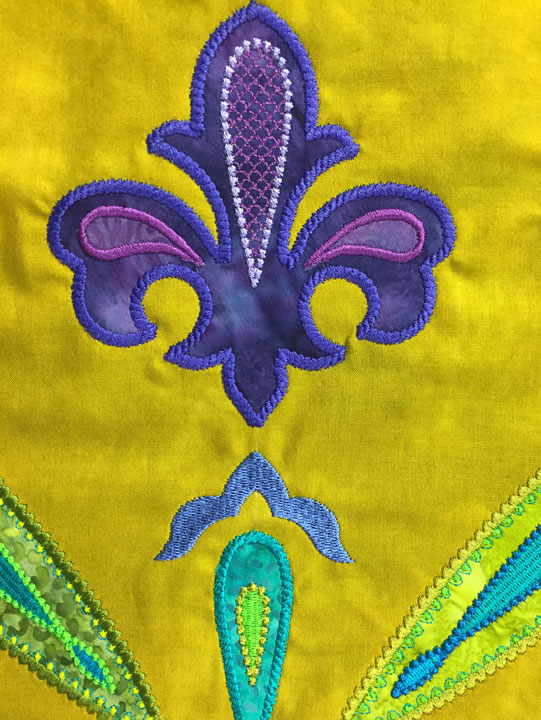
…and here’s a shot of the whole block using a little bit of a different background fabric:

I’ve finished the 4 blocks that will make the center portion of the quilt. The center will measure 47 1/2 inches square. I’m hoping to begin working on a border design in the next few days…can’t wait!
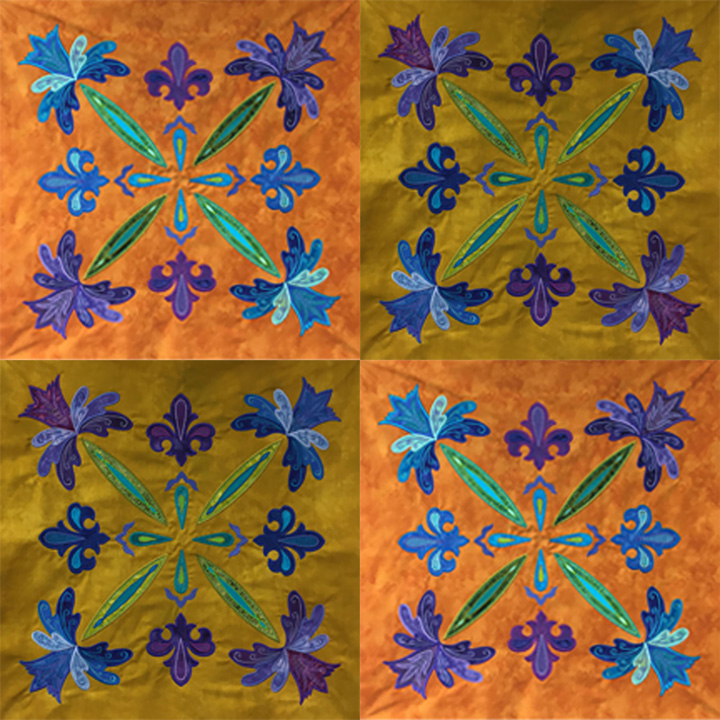
Filed under
Machine Embroidered Applique, Sizzix.
May 1st, 2018
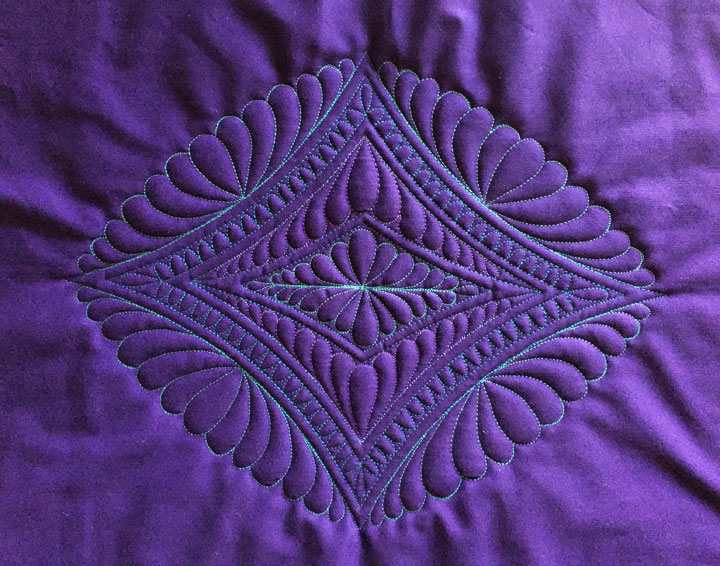
I think I’ve posted one or two times about feathered footballs like the one shown below:
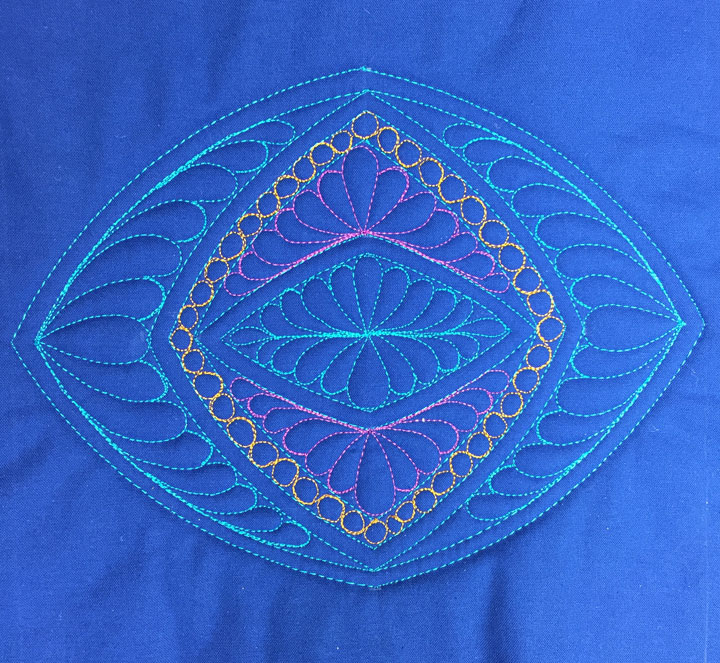
These are created using ruler work, and for feathered footballs, the orientation of the ruler is in the opposite direction as when one wants to create feathered diamonds like the one below:

(You’ll have to excuse the colors in the above photo. The background is a nice deep purple, but that was somehow lost in some of the “in-process” photos.) Anyway, when making a feathered diamond, you need to use a long ruler with a fairly subtle curve. In this case, I used the Quilters Groove Pro-echo 20 arc ruler, which you can find by clicking here. The reason you need a more subtle curve is because you’ll lose way too much “interior real estate” if the curve of the arc is acute, and then you’ll be left with nothing to play with once you go to add fill-in designs. Here’s how to make a basic feathered diamond.
Step 1: mark a large crosshair through the center of your block. I made small tick marks at 7 inches from center on one axis and 5.5 inches from center on the opposite axis. I then used my Pro echo 20 arc to create the outermost diamond framework.
Step 2: Add your interior channels. In this case, I added a 1/4 inch parallel channel, then a 1/2 inch parallel channel, then another 1/4 inch parallel channel. Using the same ruler, I then added a tapered channel using a tick mark that was placed 1 3/4 inches from the highest/lowest interior apex on the one axis. Here’s what the empty framework looked like once the ruler work skeleton was complete:

Step 3: Begin your fill in adventure! I began my fill-in work with a new thread color and added a waterfall featherette inside the tapered channel. Here’s a shot once that was completed:
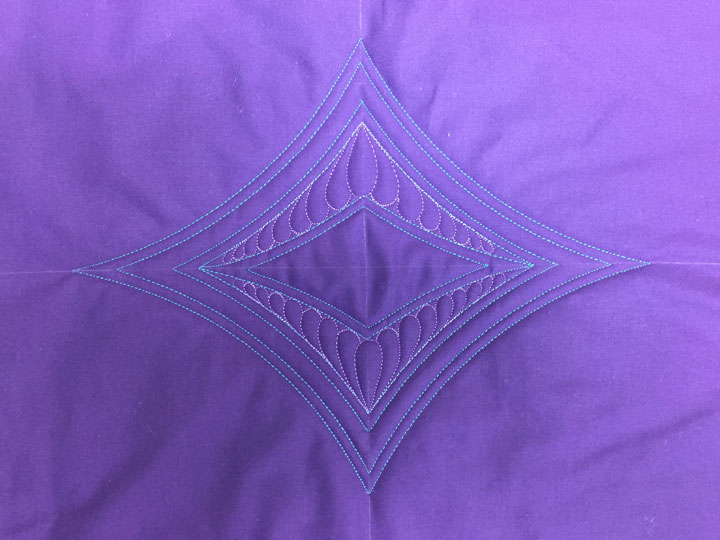
I swapped back to turquoise rayon thread and added the “fingertips” design inside the 1/2 inch parallel channel. Notice that I had to throw in a teardrop in each of the 4 corners of the diamond:
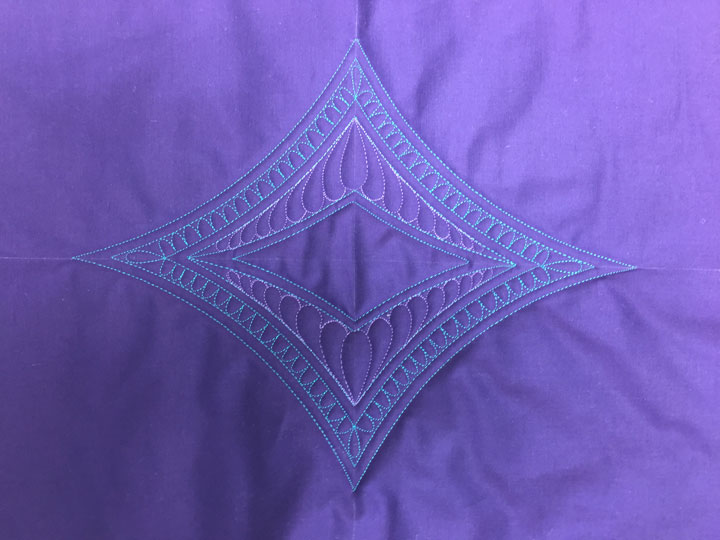
Lastly, I added an upright featherette inside the center diamond channel, and I used a different thread color (light aqua polyester) for that:

The shot above is a basic feathered diamond. This can be converted to a more elaborate feathered diamond by adding plumes along the outer edge. Because the design is highly symmetric, I felt like my outer plumes should be highly symmetric as well, so I made a temporary boundary line for them using a sliver of soap as shown below:
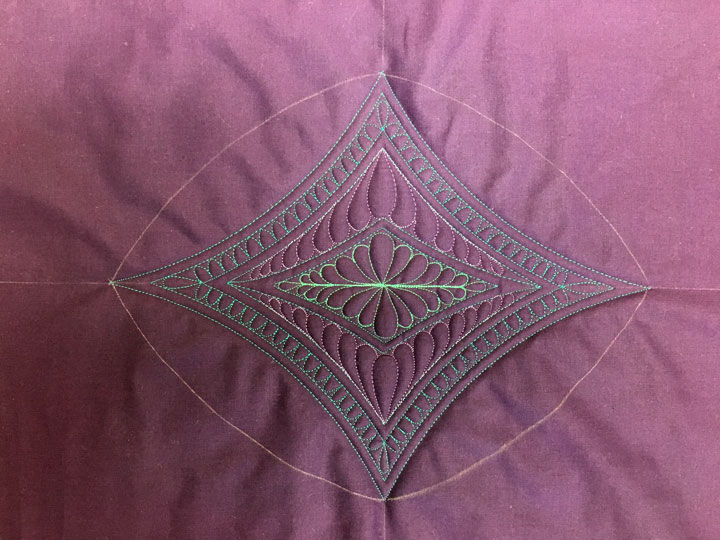
(I used my Pro-echo 22 ruler for that soap line, as it is an even more subtle curve than the Pro-echo 20 ruler I used for ruler work framework.) That soap line is important as it represents the outermost edge of my plumes. If I can force myself to “stretch” or contract each plume to meet that boundary line, I’ll end up with a lovely tapered featherette along all 4 sides. Here is a shot of that once it’s been stitched:

I am a sucker for “empty space” on a quilt sandwich, so I may end up adding something else…
Filed under
Free Motion Quilting, ruler work on a HDSM.










































